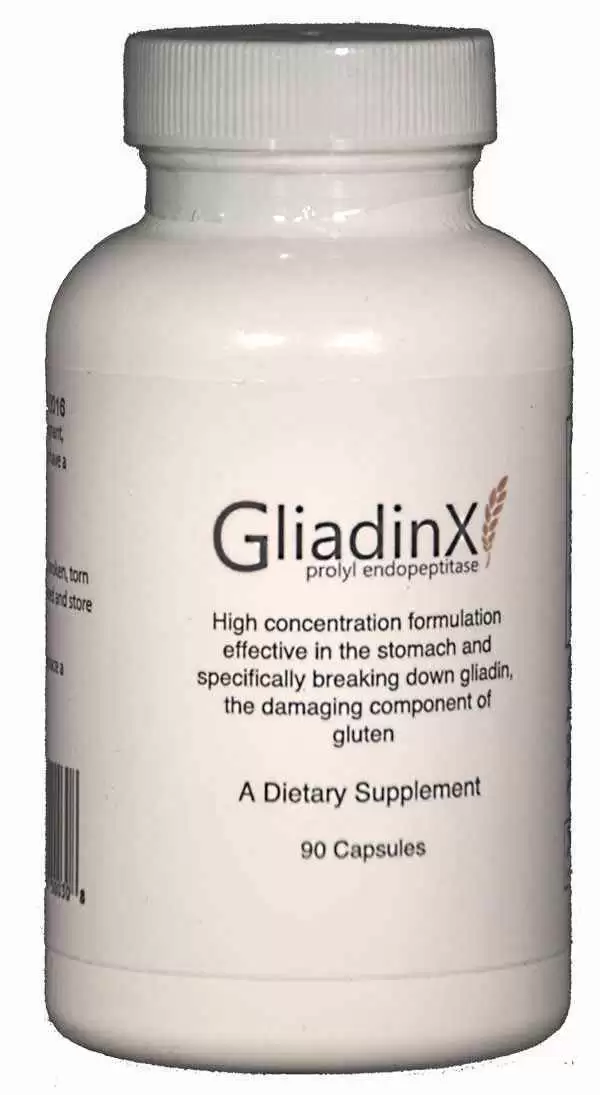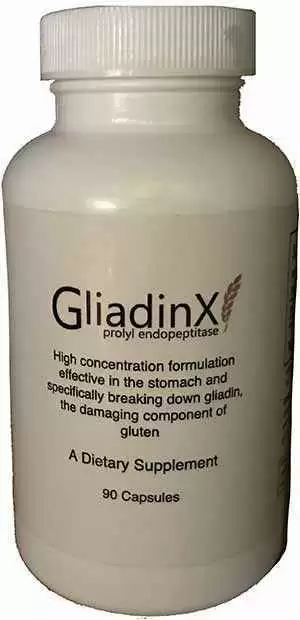
Celiac.com 03/06/2020 - Celiac disease has an incidence of about 1% in the general population. It is an automimmune disease triggered by a proline-rich protein, gliadin, when it enters the small intestine and leaks into the wall of the small intestine (therefore the name leaky gut). Humans cannot break down proline-rich proteins. In healthy persons, gliadin passes through the gastrointestinal tract and is excreted in stool and urine without consequences. Celiac patients, build antibodies in the small intestine and these antibodies travel through the blood stream in all areas of the body. In some patients, there are no apparent symptoms or they can be very mild, while in others the symptoms are quite severe and are even associated with an increased risk of a certain type of intestinal cancer.
Researchers have identified that the body breaks down some of the components of gliadin, but the human body cannot break down and digest the components that contain the amino acid proline. There are two such segments of the gliadin molecule that are causing an inflammatory reaction and they are called 33-mer and 26-mer peptides, because they contain a 33 and respectively a 26 amino acid sequence.
Celiac.com Sponsor (A12):
In an effort to prevent the gliadin molecule from leaking into the wall of the small intestine, a variety of methods have been tried. These include, closing the junctions through which gliadin leaks, encapsulating the gliadin molecule, and enzymatic degradation of the inflammatory segments of the gliadin molecule.
The smallest protein chain that can cause an inflammatory reaction is 9 amino acids long, and the goal would be to break down the gliadin molecule in segments of 8 or less amino acids. This has to happen before the gliadin molecule enters the small intestine and leak into the wall of the intestine.
The most commonly sold over-the counter enzymes are in the DPP-IV group, and while they are in fact very effective in breaking down gliadin's smaller segments, they cannot break down the proline rich areas in segments of less than 9 amino acids, and are therefore not effective in preventing an inflammatory reaction.
The three enzymes that have shown promising results are ALV003, an enzyme combination of 2 enzymes that is currently undergoing FDA testing, AN-PEP, produced by DSM, and enzyme that was originally used to make cold brewed beer clear, and a product called KumaMax, purchased by Takeda Pharmaceuticals. At this time only AN-PEP is available in various concentrations on the market. It has been particularly effective at breaking down gluten at a low pH commonly found in the stomach, and a study has shown that AN-PEP is even more effective if combined with a food grade acid. The tests were done in healthy volunteers and under laboratory conditions and several groups of researchers came to the same conclusions that AN-PEP is very effective in cleaving the gliadin molecule. The tests are considered pertinent even if healthy volunteers were selected because enzymes work in the stomach and not systemically and in that respect, there is no difference between a celiac patient and a healthy individual.
Until a few years ago, gluten-sensitivity was considered to have the same cause as celiac disease, namely the gliadin molecule and in order to avoid regulator issues, these enzymes were recommended only for gluten sensitivity but not for celiac disease. Recent work suggests that these enzymes are in fact not as effective for gluten sensitivity because the culprit of most gluten sensitivities might not be the gliadin molecule.
Enzymes Do Not Change the Nature of Celiac Disease and Do Not Treat or Cure It
Existing data is very encouraging and clearly proves that AN-PEP enzymes greatly reduce the concentration of gliadin and can possibly even make it undetectable. It is important to note, that these enzymes do not change the nature of celiac disease and therefore do not treat or cure it. They can only break down the molecule that is triggering a reaction and therefore help maintain a gluten-free diet when contaminants are present. Essentially, there are two ways to maintain a gluten-free diet. One way is to avoid any contaminants in the food but most authorities agree that this is almost unattainable. The second way, is to break down the contaminants before they can cause damage. The underlying immune-deficiency is not changed and adherence to a gluten-free diet can not be neglected. Clinicians are reluctant to recommend enzymes for gluten contamination and certainly not for intentional consumption without regulatory approval.
The big challenge is that short term gluten challenge studies have been inconclusive because they did not prove an advantage over a placebo. In order to obtain conclusive results, patients who have been on a gluten-free diet for months or even for years before they develop symptoms or antibodies, and therefore a study to prove conclusively an advantage over a placebo, is very difficult to conduct and might take years. Given this challenge, it is unlikely that an enzyme will ever go through the FDA process. As long as enzymes are not recommended to treat or cure a disease, they do not have to be FDA approved but are regulated by the FDA and have to be registered as dietary ingredients.
Enzymes Could Lead to Being Less Careful and Cause a Higher Risk of Gluten Exposure
There is the concern that enzymes could lead to being less careful and therefore causing a higher risk of gluten exposure, and this is a valid argument, but the ethical question then arises whether this is enough reason to withhold the additional benefit of safety to those who are careful.
A recent study suggests that there is a method to measure the impact of gluten with a blood test of interleukin-2 within a few hours of gluten ingestion, and the results could make a gluten-challenge study shorter and safer and could help investigate enzymes or other methods that support a gluten-free diet.
Another very promising application for enzymes is to treat gluten-containing food products and break down the immunogenic components of gliadin. These foods could not be labeled as gluten-free but only as gluten-removed. It is currently accepted that alcoholic drinks such as vodka or whiskey that are made from gluten containing grains are considered safe because of the distillation process that removes all gluten-proteins from the final product. Current laboratory tests are very accurate in determining if a product does or does not contain gluten. Currently an enzymatically treated product is not considered at the same level of safety as when gluten (gliadin molecule) is completely removed from a food product. However, at least theoretically, there should be no difference between a product that is made from non-gluten containing ingredients and a product that has been treated in a way that the finished product has no detectable gluten molecules.
In conclusion, evidence is very strong that enzymes could be recommended for the breakdown of contaminants in support of a gluten-free diet, but not to replace a gluten-free diet. This does greatly enhance the quality of life for celiac patients when eating outside of a completely controlled environment, which is not attainable for most people.
Join the forum discussion on on enzymes discussed in this article.
Studies on AN-PEP:
- Extra-Intestinal Manifestation of Celiac Disease in Children. Nutrients 2018, 10(6), 755; doi:10.3390/nu10060755
- Efficient degradation of gluten by a prolyl endoprotease in a gastrointestinal model
- Enzymatic gluten detoxification: the proof of the pudding is in the eating!
- Highly efficient gluten degradation with a newly identified prolyl endoprotease: implications for celiac disease
- Degradation of gluten in wheat bran and bread drink by means of a proline-specific peptidase
References:
- Hausch, F., Shan, L., Santiago, N. A., Gray, G. M. & Khosla, C. Intestinal digestive resistance of immunodominant gliadin peptides. Am. J. Physiol. Gastrointest. Liver Physiol. 283, G996–G1003 (2002)
- Shan, L. et al. Structural basis for gluten intolerance in celiac sprue. Science 297, 2275–2279 (2002)
- Greco, L. et al. Safety for patients with celiac disease of baked goods made of wheat flour hydrolyzed during food processing. Clin. Gastroenterol. Hepatol. 9, 24–29 (2011)
- Stoven, S., Murray, J. A. & Marietta, E. Celiac disease: advances in treatment via gluten modification. Clin. Gastroenterol. Hepatol. 10, 859–862 (2012)
- Gass, J. & Khosla, C. Prolyl endopeptidases. Cell. Mol. Life Sci. 64, 345–355 (2007)
- Mitea, C. et al. Efficient degradation of gluten by a prolyl endoprotease in a gastrointestinal model: implications for coeliac disease. Gut 57, 25–32 (2008)
- Shan, L., Marti, T., Sollid, L. M., Gray, G. M. & Khosla, C. Comparative biochemical analysis of three bacterial prolyl endopeptidases: implications for coeliac sprue. Biochem. J. 383, 311–318 (2004)
- Edens, L. et al. Extracellular prolyl endoprotease from Aspergillus niger and its use in the debittering of protein hydrolysates. J. Agric. Food Chem. 53, 7950–7957 (2005)
- Marti, T. et al. Prolyl endopeptidase-mediated destruction of T cell epitopes in whole gluten: chemical and immunological characterization. J. Pharmacol. Exp. Ther. 312, 19–26 (2005)
- Stepniak, D. et al. Highly efficient gluten degradation with a newly identified prolyl endoprotease: implications for celiac disease. Am. J. Physiol. Gastrointest. Liver Physiol. 291, G621–G629 (2006)
- Pyle, G. G. et al. Effect of pretreatment of food gluten with prolyl endopeptidase on gluten induced malabsorption in celiac sprue. Clin. Gastroenterol. Hepatol. 3, 687–694 (2005)
- Gass, J., Vora, H., Bethune, M. T., Gray, G. M. & Khosla, C. Effect of barley endoprotease EPB2 on gluten digestion in the intact rat. J. Pharmacol. Exp. Ther. 318, 1178–1186 (2006)
- Bethune, M. T. et al. A non-human primate model for gluten sensitivity. PLoS ONE 3, e1614 (2008). 29. Siegel, M. et al. Rational design of combination enzyme therapy for celiac sprue. Chem. Biol. 13, 649–658 (2006)
- Gass, J., Bethune, M. T., Siegel, M., Spencer, A. & Khosla, C. Combination enzyme therapy for gastric digestion of dietary gluten in patients with celiac sprue. Gastroenterology 133, 472–480 (2007)
- Siegel, M. et al. Safety, tolerability, and activity of ALV003: results from two phase 1 single, escalating-dose clinical trials. Dig. Dis. Sci. 57, 440–450 (2012)
- Tye-Din, J. A. et al. The effects of ALV003 predigestion of gluten on immune response and symptoms in celiac disease in vivo. Clin. Immunol. 134, 289–295 (2010)
- Lähdeaho, M. L. et al. ALV003, a novel glutanase, attenuates gluten-induced small intestinal mucosal injury in coeliac disease patients: a randomized controlled phase 2a clinical trial. Gut Suppl. 60, A12 (2011)
- Janssen, G. et al. Ineffective degradation of immunogenic gluten epitopes by currently available digestive enzyme supplements. PLos One 10, e0128065 (2015).
- Stenman, S. et al. Enzymatic detoxification of gluten by germinating wheat proteases: implications for new treatment of celiac disease. Ann. Med. 41, 390–400 (2009)
- Stenman, S. et al. Degradation of coeliac disease-inducing rye secalin by germinating cereal enzymes: diminishing toxic effects in intestinal epithelial cells. Clin. Exp. Immunol. 161, 242–249 (2010)
- Laparra, J. M. & Sanz, Y. Bifidobacteria inhibit the inflammatory response induced by gliadins in intestinal epithelial cells via modifications of toxic peptide generation during digestion. J. Cell. Biochem. 109, 801–807 (2010)
- De Angelis, M. et al. VSL#3 probiotic preparation has the capacity to hydrolyze gliadin polypeptides responsible for celiac sprue. Biochim. Biophys. Acta 1762, 80–93 (2006)
- Julia König et al. Is an enzyme supplement for celiac disease finally on the cards?
- Pages 531-533 | Received 01 Feb 2018, Accepted 02 May 2018, Accepted author version posted online: 06 May 2018, Published online: 11 May 2018
- Pinier, M. et al. Polymeric binders suppress gliadin-induced toxicity in the intestinal epithelium. Gastroenterology 136, 288–298 (2009)
- Pinier, M. et al. The copolymer P(HEMAcoSS) binds gluten and reduces immune response in gluten-sensitized mice and human tissues. Gastroenterology 142, 316–325 (2012)
- Smecuol, E. et al. Gastrointestinal permeability in celiac disease. Gastroenterology 112, 1129–1136 (1997)
- Tripathi, A. et al. Identification of human zonulin, a physiological modulator of tight junctions, as prehaptoglobin2. Proc. Natl Acad. Sci. 106, 16799–16804 (2009)
- Lammers, K. M. et al. Gliadin induces an increase in intestinal permeability and zonulin release by binding to the chemokine receptor CXCR3. Gastroenterology 135, 194–204 e193 (2008)
- Di Pierro, M. et al. Zonula occludens toxin structure-function analysis. Identification of the fragment biologically active on tight junctions and of the zonulin receptor binding domain. J. Biol. Chem. 276, 19160–19165 (2001)
- Leffler, D. A. et al. A randomized, double-blind study of larazotide acetate to prevent the activation of celiac disease during gluten challenge. Am. J. Gastroenterol. 107, 1554–1562 (2012)
- Kelly, C. P. et al. Larazotide acetate in patients with coeliac disease undergoing a gluten challenge: a randomised placebo-controlled study. Aliment. Pharmacol. Ther. 37, 252–262 (2013)
- Katharina Anne et al. Novel approaches for enzymatic gluten degradation to create high-quality gluten-free products https://doi.org/10.1016/j.foodres.2016.11.021












Recommended Comments
Create an account or sign in to comment
You need to be a member in order to leave a comment
Create an account
Sign up for a new account in our community. It's easy!
Register a new accountSign in
Already have an account? Sign in here.
Sign In Now